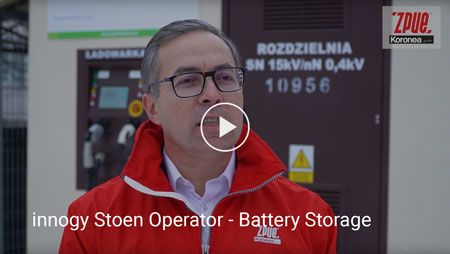














There is a place for battery storage
The main purpose of battery storage is to balance the grid in the daily cycle, ease the load on the power grid at peak demand and store electricity when it is overproduced. This is especially important in the case of non-controllable renewables. Large-scale battery storage can absorb the surplus electricity when the production of wind and solar electricity exceeds demand, and then releases it into the grid when renewable energy resources are insufficient to meet the demand.
The implementation of battery storage is a necessary condition to stabilise the system and decarbonise the energy sector, and at the same time improve energy security. It is of great importance, especially for inherently unstable renewable sources. Currently, the cheapest and most dynamically developed technologies are based on electrochemical cells, mainly lithium.
Battery storage is an effective measure to improve the efficiency of energy management. It has been used for a long time, as exemplified by pumped storage power plants. In recent years, the dynamic development of electrochemical cell technology makes it possible to build smaller, cheaper battery storage facilities and create new opportunities for the development and better use of existing distribution systems.
Battery storage integrated with substations and independent facilities have been constructed for several years and will become more and more common. Energy stored in renewable electrochemical reservoirs has been used for years. There are several cell design technologies, which are developed and improved. There are also some new technologies being developed which are predicted to soon enter the industrial implementation phase.
Przedział cenowy: 1 000 000 zł - 1 000 000 zł
Przedział cenowy: 1 000 000 zł - 1 000 000 zł
Przedział cenowy: 1 000 000 zł - 1 000 000 zł
Przedział cenowy: 1 000 000 zł - 1 000 000 zł
Przedział cenowy: 1 000 000 zł - 1 000 000 zł
Przedział cenowy: 1 000 000 zł - 1 000 000 zł
Przedział cenowy: 1 000 000 zł - 1 000 000 zł
Przedział cenowy: 1 000 000 zł - 1 000 000 zł
Progress in the charging / discharging speed of battery storage is made every day. It is expressed by the C rating which, depending on the battery capacity, determines the value of the permissible charging or discharging current. Of the currently used batteries, lithium-ion cells made with the LTO technology have the highest C rating. The battery storage is optimised when the largest possible battery storage is built, but at the same time the smallest possible volume of the battery storage is desired - this is the case with EV batteries - the goal is to use the highest energy density expressed in kWh/kg. Currently the technologies used are NMC or LFP lithium-ion cells.
the environment
The problem of battery storage safety is associated with the limiting the impact of an operating battery storage on the environment and minimizing the risk of damage caused by failure. In this context, efforts are being made to use solid cells that do not emit any substances during operation - especially gases, and these solid cells must be characterized by the lowest possible flammability and sensitivity to high temperatures.
There is a steadily growing interest in new technologies of electrochemical cells. Lithium-ion batteries have been used for many years in applications requiring a large number of charge and discharge cycles. Reduced weight, improved operational reliability, extended lifetime, and operation in a wide temperature range are the areas that many scientists are working on, achieving better and better results.
Currently, four battery storage design technologies are used on the market — three lithium-ion cell and one supercapacitor technology. Lithium-ion cell technologies differ primarily in the types of materials used to produce the cathode and anode.
Intercalation is the insertion of lithium ions into the crystal structure of a solid body without changing its structure. Lithium ions enter the interatomic spaces of the crystal.
The process produces a lithium ion at the anode. Lithium ions deintercalate, leaving the anode crystal structure. Then ions diffuse in the electrolyte towards the cathode and intercalate into the cathode material. The migration of Li+ ions between the electrodes reduces the energy of the system and causes flow of electrons in the external circuit of the battery. The reverse process occurs during charging.
Charing begins by applying an external voltage source to the electrodes. The electrical potential on the positive electrode causes electrochemical reaction and lithium is oxidized to the Li+ lithium ion. This reaction is accompanied by deintercalation of Li+ ions from the cathode material and the ions migrate through the electrolyte and intercalate into the anode.
Application:
Electromobility and stationary battery storage.
The lithium-nickel-manganese-cobalt-oxide, abbreviated NMC is one of the lithium-ion battery technologies where the nominal voltage is 3.7V. Batteries can operate at temperatures from –20oC to +60oC and are charged with a current of 1~2C and discharged with a current of 3C. Service life up to 4000~5000 cycles. In this battery technology, the positive electrode consists of nickel, manganese and cobalt in various proportions. The negative electrode is made of graphite. This battery technology is characterized by the highest energy density and the most attractive price. A solution dedicated to storing high energy off-peak and long discharges.
Application:
Stationary battery storage.
The lithium iron phosphate, abbreviated LFP is one of the lithium-ion battery technologies of where the nominal voltage is 3.2V. Batteries can operate at temperatures from –30oC to +50oC and are charged with a current of 2~4 Cand discharged with a current of 3C. Service life up to 4500~6000 cycles. In this battery technology, the positive electrode is lithium iron phosphate (LiFePO4). The negative electrode is made of graphite. The great advantage of this technology is the ability to charge the battery at temperature below 0oC. A solution dedicated to storing high energy off-peak and long discharges.
Application:
Stationary battery storage to stabilise grid parameters.
The Lithium titanate (lithium titanium oxide) or LTO is one of the lithium-ion battery technologies where the nominal voltage is 2.4 V. Batteries can operate at temperatures from –10oC to +40oC and are charged with a current of 5~10C and discharged with a current of 10C. Service life up to 10.000~20.000 cycles. In this battery technology, the positive electrode is made of carbon while the negative electrode is titanium oxide Li4Ti5O12. LTO technology has the highest power density and lifetime, but low energy density. The great advantage of this technology is the ability to charge the battery at temperature below 0oC. This technology is suitable for applications where frequent high power charging is planned in a short time, i.e. where the battery system does not require large capacity
There is a place for battery storage
between your business and the energy sector.

The main purpose of battery storage is to balance the grid in the daily cycle, ease the load on the power grid at peak demand and store electricity when it is overproduced. This is especially important in the case of non-controllable renewables. Large-scale battery storage can absorb the surplus electricity when the production of wind and solar electricity exceeds demand, and then releases it into the grid when renewable energy resources are insufficient to meet the demand.
The implementation of battery storage is a necessary condition to stabilise the system and decarbonise the energy sector, and at the same time improve energy security. It is of great importance, especially for inherently unstable renewable sources. Currently, the cheapest and most dynamically developed technologies are based on electrochemical cells, mainly lithium.
Battery storage is an effective measure to improve the efficiency of energy management. It has been used for a long time, as exemplified by pumped storage power plants. In recent years, the dynamic development of electrochemical cell technology makes it possible to build smaller, cheaper battery storage facilities and create new opportunities for the development and better use of existing distribution systems.
Battery storage integrated with substations and independent facilities have been constructed for several years and will become more and more common. Energy stored in renewable electrochemical reservoirs has been used for years. There are several cell design technologies, which are developed and improved. There are also some new technologies being developed which are predicted to soon enter the industrial implementation phase.



Przedział cenowy: 1 000 000 zł - 1 000 000 zł
Przedział cenowy: 1 000 000 zł - 1 000 000 zł

industry and production companies

Przedział cenowy: 1 000 000 zł - 1 000 000 zł
Przedział cenowy: 1 000 000 zł - 1 000 000 zł


Przedział cenowy: 1 000 000 zł - 1 000 000 zł
Przedział cenowy: 1 000 000 zł - 1 000 000 zł



Progress in the charging / discharging speed of battery storage is made every day. It is expressed by the C rating which, depending on the battery capacity, determines the value of the permissible charging or discharging current. Of the currently used batteries, lithium-ion cells made with the LTO technology have the highest C rating. The battery storage is optimised when the largest possible battery storage is built, but at the same time the smallest possible volume of the battery storage is desired - this is the case with EV batteries - the goal is to use the highest energy density expressed in kWh/kg. Currently the technologies used are NMC or LFP lithium-ion cells.
the environment
The problem of battery storage safety is associated with the limiting the impact of an operating battery storage on the environment and minimizing the risk of damage caused by failure. In this context, efforts are being made to use solid cells that do not emit any substances during operation - especially gases, and these solid cells must be characterized by the lowest possible flammability and sensitivity to high temperatures.
There is a steadily growing interest in new technologies of electrochemical cells. Lithium-ion batteries have been used for many years in applications requiring a large number of charge and discharge cycles. Reduced weight, improved operational reliability, extended lifetime, and operation in a wide temperature range are the areas that many scientists are working on, achieving better and better results.

Currently, four battery storage design technologies are used on the market — three lithium-ion cell and one supercapacitor technology. Lithium-ion cell technologies differ primarily in the types of materials used to produce the cathode and anode.
Intercalation is the insertion of lithium ions into the crystal structure of a solid body without changing its structure. Lithium ions enter the interatomic spaces of the crystal.
The process produces a lithium ion at the anode. Lithium ions deintercalate, leaving the anode crystal structure. Then ions diffuse in the electrolyte towards the cathode and intercalate into the cathode material. The migration of Li+ ions between the electrodes reduces the energy of the system and causes flow of electrons in the external circuit of the battery. The reverse process occurs during charging.
Charing begins by applying an external voltage source to the electrodes. The electrical potential on the positive electrode causes electrochemical reaction and lithium is oxidized to the Li+ lithium ion. This reaction is accompanied by deintercalation of Li+ ions from the cathode material and the ions migrate through the electrolyte and intercalate into the anode.

Application:
Electromobility and stationary battery storage.
The lithium-nickel-manganese-cobalt-oxide, abbreviated NMC is one of the lithium-ion battery technologies where the nominal voltage is 3.7V. Batteries can operate at temperatures from –20oC to +60oC and are charged with a current of 1~2C and discharged with a current of 3C. Service life up to 4000~5000 cycles. In this battery technology, the positive electrode consists of nickel, manganese and cobalt in various proportions. The negative electrode is made of graphite. This battery technology is characterized by the highest energy density and the most attractive price. A solution dedicated to storing high energy off-peak and long discharges.
Application:
Stationary battery storage.
The lithium iron phosphate, abbreviated LFP is one of the lithium-ion battery technologies of where the nominal voltage is 3.2V. Batteries can operate at temperatures from –30oC to +50oC and are charged with a current of 2~4 Cand discharged with a current of 3C. Service life up to 4500~6000 cycles. In this battery technology, the positive electrode is lithium iron phosphate (LiFePO4). The negative electrode is made of graphite. The great advantage of this technology is the ability to charge the battery at temperature below 0oC. A solution dedicated to storing high energy off-peak and long discharges.
Application:
Stationary battery storage to stabilise grid parameters.
The Lithium titanate (lithium titanium oxide) or LTO is one of the lithium-ion battery technologies where the nominal voltage is 2.4 V. Batteries can operate at temperatures from –10oC to +40oC and are charged with a current of 5~10C and discharged with a current of 10C. Service life up to 10.000~20.000 cycles. In this battery technology, the positive electrode is made of carbon while the negative electrode is titanium oxide Li4Ti5O12. LTO technology has the highest power density and lifetime, but low energy density. The great advantage of this technology is the ability to charge the battery at temperature below 0oC. This technology is suitable for applications where frequent high power charging is planned in a short time, i.e. where the battery system does not require large capacity




